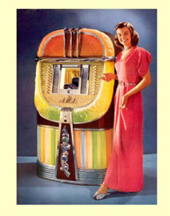
Jukebox Aesthetics in the Swing Era
Put another Nickel In!

Here are some helps to finding things on this page.
- Overview and Introduction (This Page)
- Part 1: Mechanics (Separate Page)
- Juke Box Aesthetics (This Page)
- The Wood Era
- The Golden Era of Bakelite
- Wurlitzer Jukeboxes
- AMI Jukeboxes
- Seeburg Jukeboxes
- The Seeburg "Crown"
- The Seeburg "Casino"
- Seeburg Symphonola "Classic"
- Seeburg Symphonola "Colonel"
- The Seeburg "Commander"
- The Seeburg 9800 "Hi-Tone"
- The Seeburg Models S-146 - S-148 "Trashcan"
- Seeburg "Model 100 A"
- Rock-Ola Jukeboxes
- Mills Novelty Company Jukeboxes
- Packard Jukeboxes
- Jukebox Companies (Separate Page)
- Epilogue (Separate Page)
This "Introduction" is on all three jukebox pages. If you have read it before (or don't want to read it), you can go directly to the pictures of Jukeboxes.
If you're reading this in 2009 (or later), the word "jukebox" means a gaudy prop in a retro diner or an image on a "Fabulous Fifties" party favor. In fact, if not for retro theme restaurants (like the Silver Diner), most of you would have never seen or heard of a jukebox. It is about a 50-1 bet that none of you have ever seen a real mechanical jukebox playing 78 rpm records, and it's about 1000-1 that any of you ever played a song for a nickel in a roadhouse. I'm writing this to integrate a lot of information that's out there on the internet. I'm going to package it for you so that you get a little history, a little mechanical engineering, some business strategy and a true aesthetic experience. We're also going to toss in some of the original patents so that you can see how things work.
First of all, they're not jukeboxes -- back in the day, they were known as coin-operated phonographs. They were found in the best of establishments and were a multimillion dollar business. The cast of characters includes a wide variety of colorful individuals including brilliant designers, a millionaire right-wing Senator, gangsters, and even the KGB. This was cutting-edge technology that pushed electro-mechanics to its limits. It was the beginning of "hi-fi" and it was the pulse of the nation's taste in music -- the Radio and TV show Your Hit Parade informed listeners that the ratings were based on a survey of:
"the best sellers on sheet music and phonograph records, the songs most heard on the air and most played on the automatic coin machines, an accurate, authentic tabulation of America's taste in popular music."
Most people who danced during the period 1930-1950 did so to music provided by a jukebox. With the exception of the very, very elite places, most restaurants from Chez Pierre to Pete's Bar had a coin-operated phonograph to provide dance music to their customers. This was a LOT of places, and it is generally estimated that two million boxes were made. The folks who made coin operated phonographs (principally Wurlitzer, AMI and Seeburg) engaged in large scale nationwide advertising campaigns to convince poeople that the jukebox was a legitimate and "high-class" form of entertainment. Of these, Wurlitzer is the most remembered name, thanks to two factors: (1) a remarkable series of full-page ads drawn by Albert Dorne and (2)the Model 1015 Jukebox, both of which are shown below:
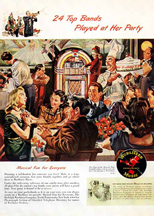
1947 Albert Dorne Ad Featuring the Wurlitzer Model 1015 Jukebox
Click to Enlarge
By examining this ad, we can learn a little about the times. First, you'll note that this scene takes place in a fairly classy restaurant -- the waiter (upper left) is wearing a mess jacket. There is a mural of a prince and princess on the wall, and the headwaiter (smiling at the kitchen door in black tie) is presiding over a birthday party for a lucky young lady. Not only that, a cliche chef in toque and pencil moustache has prepared a special (and large) birthday cake. There are a dozen roses on the table. All of the [clearly] non-ethnic patrons are having the time of their life. There is nothing at all about this scene that could be remotely considered as "low class." Here are some ads from the Seeburg company's internal paper. One shows a really classy Art Deco bar that had recently been "closed" to jukeboxes; the other shows a white-tie wedding with music by a jukebox. [this was only possible in the Seeburg magazine...]

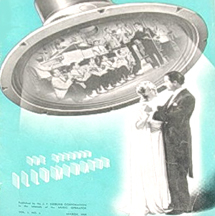
Seeburg Ads suggesting that the Juke was High Class
Click to Enlarge
As you might guess, there is a little sociology involved here. Manufacturers were continuously improving the technology and appearance of their products, sometimes with new variants issued on a monthly basis. The "very latest" machines with the most features and the best styling were designated "Top Boxes" and were destined for high end establishments. As the new moved in, the old was recycled down the status chain (of the time) until they reached rock bottom in the seedier roadhouses. In those bigoted times, when the machines reached into Negro neighborhoods, they acquired their enduring name, since "Juke" was slang at the time for "dancing". This is a lot less of a mouthful than "automatic coin operated phonograph," so like "Jitterbug", "Zoot" and "Rebop" the African-Americans had the last word. On a sad note, after the machine had been recycled down the chain, it was scavenged for parts and the rest destroyed. This is why boxes from the 1920s and 1930s are very rare.
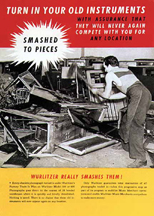
We Really Smash Them
Wurlitzer Trade Ad from the 1930s
By a new jukebox! The old one won't compete with you...
In 1942-1945, the were sent overseas with the Armed Forces
Click to Enlarge
The Model 1015 had the largest production run of any single jukebox model. Wurlitzer estimates that more than 60,000 of the units were shipped. With bubbler tubes that changed colors, it was very entertaining -- so much so that owners preferred to keep this model instead of switching to newer boxes, even those with much improved technology. When the industry moved from 78 rpm to 45 rpm records, many of the 1015s were retrofitted and continued to serve in the 1950s. The natural downward evolution of the jukebox placed this machine in malt shops, drug stores and other places frequented by teenagers just at the time that Rock'n'Roll was emerging. The 1015 is, in fact, an icon of teen culture in the mid-1950s even though it was introduced in 1947 to play the music of their parents (see ad above.). It is the most often pictured jukebox and is immediately recognizable today. In fact, the remnants of the Wurlitzer company still makes them today -- they play CDs and some even use iPod technology to offer thousands of selections.
You have a some choices now:
- Read about Jukebox Mechanics Separate page
- Read about Jukebox Aesthetics -- Continue on THIS Page
- Read about Companies that made Jukeboxes Separate page
- Read about The end of the Jukebox Era Separate page
- Look at Some Other Kind of Swing Era Nonsense
It would be a serious mistake to underestimate the importance of the package that encloses the jukebox. In essence, the last thing that the company does is the first thing that the public sees. The fact that the vast majority of you have skipped over the mechanics section is proof positive that the aesthetic design of the jukebox is the key to its success. The public did not care about the elegance or reliability of the machinery inside the box -- they wanted to invest their hard-earned Depression-era nickel in an elegant fantasy. Manufacturers knew that the customer must be attracted to the machine, so it must stand out. The customer must be able to clearly see his musical options and easily choose them. The customer must receive some visual reward in addition to his chosen songs -- the music must emanate from something rather than a ghostly presence in thin air. Finally, the customer must believe that by playing the machine he is part of a positive, sophisticated, well-thought of group. You'll also recall the plastics, bright colors, bubble tubes, chrome and the like were idolized in the 1930s as part of a much better "future," the present being so very dreary. It is only when the giddy display became commonplace (and the times like the 1950s more conservative) that jukeboxes began to be considered gaudy and vulgar. Finally, manufacturers had to tread a thin line between the cost of the sophisticated adornment and the likely revenue from the machine -- the absolute maximum possible revenue from the machine was about $1.00 per hour (that is, about 20 three-minute plays at a nickel each). However, if you haven't read the section on mechanical cabinet requirements, you will miss the constraints of the mechanism on the shape of the jukebox. Thus, the aesthetics of coin-operated phonographs are a compromise between vision, mechanics, and economics.
The general tone of American Society in the Swing Era was that:
(a) Things couldn't be much worse than the Great Depression; and(b) Science is going to provide a wonderful future for everyone.
The former is probably true, but the latter has been marked with mixed success. However, Faith in the Future, (stimulated by the 1933 Columbian Exposition and the 1939 World's Fair) created an intense popular interest in new styles and new materials. The Depression was pretty dull -- the public began to reject Puritan plain and came to like things that were new and bright. However, flashy light-up jukeboxes did not spring out of thin air (or the World's Fair) -- they evolved gradually through the orderly business process of introducing new designs to the market.
The Jukebox of the 1930s had a regular life cycle. A new "Top Box" was placed in a high value environment, and gradually was sent down the value chain until it was salvaged. The various companies had a fairly large investment in mechanicals - the patents, production machinery and service training -- so they were reluctant to introduce radical changes in the underlying "hardware." Following the lead of the auto industry, jukebox manufacturers devoted most of their model changes to the exterior. While the appearance changed every year, the mechanicals changed very gradually -- in 1947, Wurlitzer jukeboxes were using a changer mechanism that was quite similar to that in 1930, the models differing only in terms of refinements that would increase revenue: more selections that were easier to make. As we have seen, AMI and Seeburg tried to compete on the basis of sound quality, but made only limited intrusion into Wurlitzer's market. Seeburg only took off when it offered a 100 (and then 200) selection machine.
One consequence of the relatively unchanging internal mechanism were limits on the size and shape of the exterior. During the period 1930-1950, Wurlitzer machines "evolved" slowly from the "Box" to the "Arch" shape that has become iconic. All of the machines were designed by one man, Paul Fuller. The photo below shows the beginning and the end of the evolutionary process. In general, the year-to-year changes revolved around the vertical elements (the Pilasters) and the changer display in the "Crown". The early model lets you look at the changer through a window. The final model has a clear plastic nose cone that reminded many of the bombardier's compartment on a B-29.
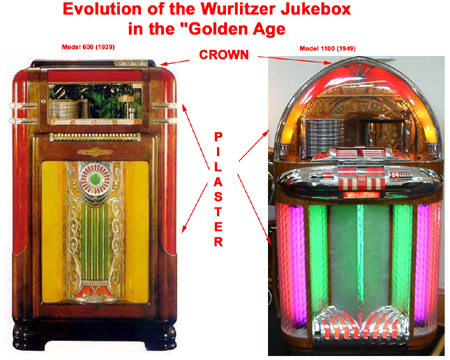
Beginning and End of Evolution of the Wurlitzer Jukebox in the Golden Age
From box to arch...
Model 600 and Model 1100 pictured
Click to Enlarge
Between this "beginning" and "end" stage, there were a number of variants.
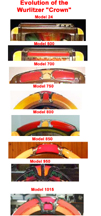
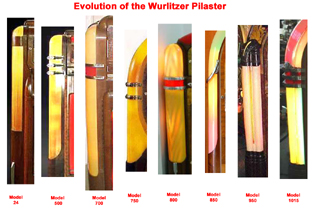
Evolution of the Crown and Pilaster in Wurlitzer Jukebox Models
Click to Enlarge
The pictures above show the evolutionary steps between the Model 600 and the Model 1100. Note that they are gradual in character and retain many of the same elements. The Crown of the jukeboxes has a device in the center that resembles a keystone of an arch. Success of a feature led to its enhancement. The Model 800 has outsized pilasters that look like pontoons. The Model 750 initiated the Arch design, but the window was out of proportion, giving the machine an unbalanced look. In the Model 1080 Wurlitzer attempted to create a "conservative" design for places that did not fancy Art Deco -- but they used the same basic "arch" framework. During World War II, most jukebox manufacturing was shut down and the various companies made precision instruments for the Armed Services.
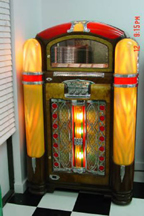


Evolutionary Dead-Ends in Wurlitzer Jukeboxes
Wurlitzer Model 800, Model 750, Model 1080
Yes, they were created by Paul Fuller, but they evolved in the business environment...
Click to Enlarge
After the war, materiel shortages forced companies to recycle. Many of the boxes from 1945-1949 are simply restyled versions of previous machines. There isn't a whole lot of structural difference between the Model 850, 950, or 1015, although the decorative details vary widely.
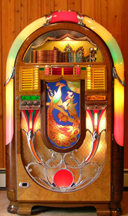
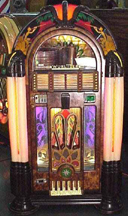

Recycling in Wurlitzer Jukeboxes
Wurlitzer Model 850, Model 950, Model 1015
Click to Enlarge
The process of Jukebox design was carefully governed by business necessity -- and not by the visionary dreams of pure art. This is certainly not to take away from the genius of Paul Fuller or Henry Roberts, but simply a reminder that "Ars Gratia Pecunia" was the operative principle in the jukebox business.
The next two sections treat the critical periods before and after which Art Deco styling and modern materials began to emerge.
In the beginning, coin operated phonographs looked a lot like their home-based counterparts.

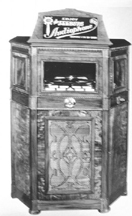
In the 20s, a Phonograph is a Phonograph, Home or Away
Domestic Phonograph Design Patent D-99,277
Seeburg Audiphone c. 1928
Click to Enlarge
Click here if you want to learn how to get Patent Drawings
During the Great Depression, manufacturers found that they had to work a whole lot harder to get the customer to part with his/her hard-earned nickel. Wurlitzer and Seeburg, the "prestige" companies made wooden boxes, often with a high degree of traditional craftsmanship. On the other hand, the manufacturers of slot machines (Rock-Ola and Mills) and vending machines (AMI) employed "modern" design to attract customers, often using mirrors, bright lighting and the "streamlined" style that was very popular in films and luxury trains. The established manufacturers first tried to adapt wood construction to the new forms. In the beginning, "all-wood" models had an advantage since the craftsmen were already in place and understood the internal company operations.
1n 1934, Wurlitzer took a step away from lyres, curlicues and church organs and produced new Deco-styled models, called the "P-Series" (the "Princess", "Debutante", etc). Although they had smooth lines and veneer effects, the P Series had only moderate success. In 1934 there was significant sales resistance due to the depression, and it was debatable whether people were rejecting Art deco design or jukeboxes in general. In 1936, Wurlitzer got into Deco in a big way with the "300" series (The "Modern") which also had limited acceptance.
During the period 1934-1937, Paul Fuller, the genius behind Wurlitzer's styling turned out a wide variety of Art Deco-styled boxes using fanciful veneer schemes, not at all unlike the trends in furniture. These boxes used the Simplex mechanism, increasing the number of selections gradually from 12 to 24. These last vestiges of the all-wood jukebox are quite attractive and serviceable. Because Wurlitzer had a policy of destroying old boxes, these machines are now quite rare.
Finally, "reluctance to spend" was ruled out given dramatic increases in sales of other products therough brightly lit vending machines. The jukebox manufacturers finally came to the conclusion that a significant potion of the public was willing to step into the future. Their initial policy was to manufacture both kinds of boxes, thinking that the upper classes would prefer the richness of traditional woods (actually veneers on plywood). As we'll see below, sales figures ended the all-wood jukebox cabinet by 1940 (roughly).
Wurlitzer P-12 "Princess"
The "P" series is a very hesitant step into the world of Art Deco. It is plain but tasteful, the kind of thing that middle class people were supposed to want. It did not sell well.
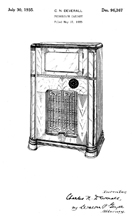
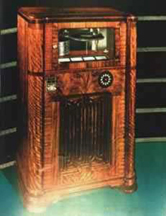
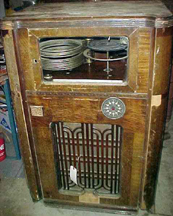
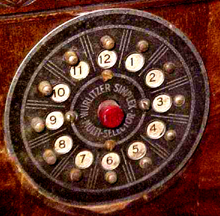
Thw Wurlitzer Model P-12 ("Princess" Jukebox
Design Patent D - 96,367
Catalog photo
A P-12 in unrestored condition
The Wurlitzer Simplex Multi-Selector Dial
Click here if you want to learn how to get Patent Drawings
Here is a video of a Wurlitzer Model P-12 jukebox that shows the selection and changer mechanism in action. The song is "Jabalaya", sung by Jo Stafford.
The Wurlitzer Models 312-316 "Modern"
This represents Wurlitzer's definite, "no hesitation" entry into full-bore Deco -- turquoise pilasters, and styling that suggested a face, with the speaker compartment as the open mouth. This box was designed by Paul Fuller and reflects his fascination with pilasters that lasted through the rest of his career at Wurlitzer.

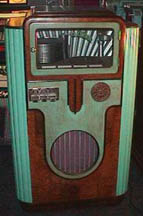
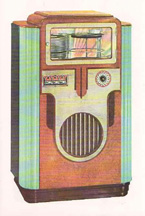
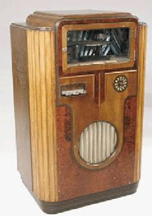
The Wurlitzer Modern
Design Patent D-99,277
(left to right)
Click here if you want to learn how to get Patent Drawings
The Wurlitzer Model 51
Wurlitzer manufactured this small "table model" jukeboxes for establishments with limited space -- the record changer, selector and coin handling mechanisms were packaged in a small box while the amplifiers and speakers were remotely located. This enabled a small lunch counter or diner to feature recorded music. It was easy for patrons to put some loose change into the machine and those additional nickels helped soften the blow of the Great Depression for Wurlitzer.
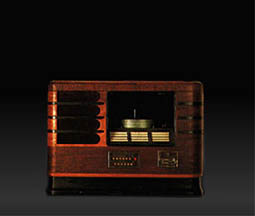
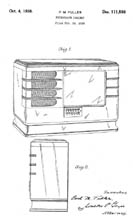
The Wurlitzer Model 51
Paul Fuller Design Patent D111,598
Click to Enlarge
Click here if you want to learn how to get Free Patent Drawings
Above is the Wurlitzer Model 51, the rarest of all Wurlitzer table models, because it was the only one made without illuminated plastics. It was manufactured in 1937 and reflects the early 30s pre-light-up design. It was probably intended as an "economy" model.
Wurlitzer Model 616 Version 1
Wurlitzer produced two slightly different variants of the Model 616. Each has a separate design patent (both by Paul Fuller.) All of them used the Simplex (round selector) and had almost no plastic, although Fuller gave them true Art Deco styling. The patent for Variant 1 (sometimes called Grade 1) was filed on February 5, 1937. There is no color used on the machine. These are incredibly rare, and it is hard to find actual photos of them.
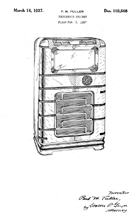

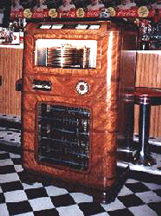
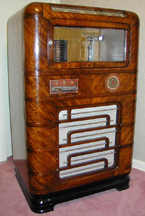
The Wurlitzer Model 6161 (Variant 1) Jukebox
(Left to Right)
Design Patent D-103,658, Catalog Photo, Two Collecrors' Photos
Click here if you want to learn how to get Patent Drawings
At the same time that Variant 1 was being produced, Wurlitzer developed the Model 616-A Counter-Top model. As shown below, it is more-or-less the top half of Variant 1, although it appears to have only a 12 disc selector.
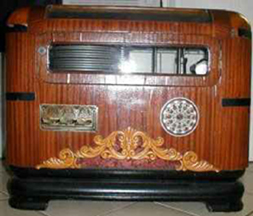

Wurlitzer Model 616-A Countertop Juke Box
Click to Enlarge
Wurlitzer Model 616 Version 2
Paul Fuller submited the design patent for Version 2 of the Model 616 on October 4, 1937, about 8 months after the patent for Variant 1. The major difference between the two was the introduction of colored lighting, both in the record changer space and in the grille.
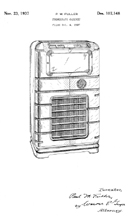
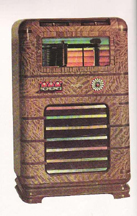
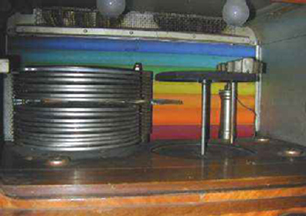
The Wurlitzer Model 616 Jukebox, Variant 2
Design Patent D-107,148
Catalog photo and Details of color field in the changer compartment
Click to Enlarge
Click here if you want to learn how to get Patent Drawings
Here is a video of a Wurlitzer Model 616-B jukebox that shows the selection and changer mechanism in action.
Both versions of the Model 616 offered 16 selections instead of 12. This tempted the marketplace, but the 616 did not produce the sales results that Wurlitzer desired.
Wurlitzer Model 716
According to the catalog picture, the Model 716 had a burl walnut finish with painted red pilasters, evocative of the "modern.". The only photo of the 717 that I could find was in deplorable condition and the owner admitted that it has the wrong grille. (It also had an atrocious faux finish.) I've tried to "restore" this photo by using the magic of Photoshop.
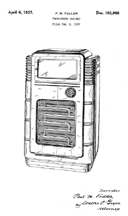
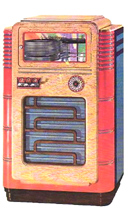
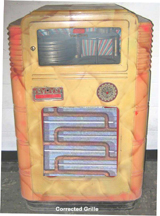
The Model 716 Jukebox as it is Supposed to be...
(Left to Right): Design Patent D-103,966, Catalog Photo,as "Photorestored"
Click to Enlarge

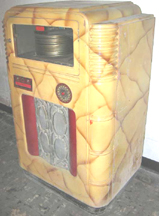
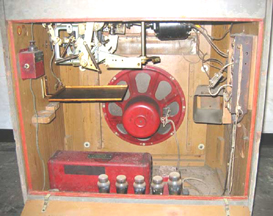
Current condition of the Model 716
Wrong Grille, Horrible Paint Job
Click to Enlarge
Click here if you want to learn how to get Patent Drawings
The Model 716 sold no better than the 616 line. In 1938, they conducted an experiment pitting a wood box (the Model 50 against a plastic light-up juke ( the Model 24).
The Wurlitzer Model 50 "Console"
The Model 50 represented the aggregate of all the "best" features in a wood jukebox. Apparently designed by a committee, this is the "Modern" without the turquoise pilasters, but retaining the "open mouth" speaker. The veneer work is spectacular. With the exception of the curlicues in the grill, this is right in step with the best French Art Deco furniture of the period. Paul Fuller gets the credit for the Model 50.
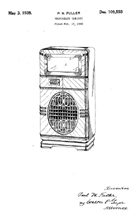
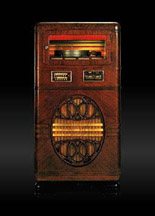
The Wurlitzer Console 50
Design patent D-109,555
Click here if you want to learn how to get Patent Drawings
Here is a video of the Wurlitzer model 50 in action, playing "Swing High" by the Tommy Dorsey Orchestra
This is a video of the Model 50 mechanism in action.
The difference this time was that Wurlitzer was also offering a "light-up" jukebox that incorporated plastic panels. The Model 50 was not successful. Wurlitzer never went back to all wood, and their sales skyrocketed. Seeburg and Rockola had a similar history. By 1938 everybody was making gee-whix jukeboxes that did everything but reach into your pocket for a nickel.
The Rock-Ola "Model A"
David Rockola, fresh from a brush with the law in Chicago over slot machines, settled in California and began to manufacture jukeboxes. His first efforts had wood cases that were not particularly interesting. They are included here to show representative examples of what Wurlitzer's competition was doing during the "wood" era.
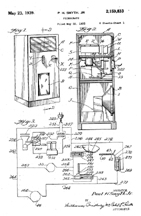

The Rock-Ola Model A
Patent No. 2,159,833
Click to Enlarge
Click here if you want to learn how to get Patent Drawings
The Rock-Ola Model B, "Rhythm King and Imperial"
Our reader Andrew provided a clarification about the "Model B". Apparently it began as a snappy 12 disc box called the "Rhythm King" and evolved into a fairly stodgy machine called "The Imperial" -- Andrew writes:
"... In the Rock-Ola Model B section you show a patent drawing for the Rock-Ola Rhythm King from 1937. I owned one of those for many years, and the striking grille pattern with the musical notes carved in, plus other little details are tell-tale of that machine. The 'Imperial' was a 24 record machine. The Rhythm King only held 12 records. ..."
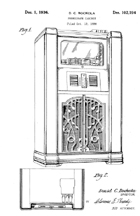
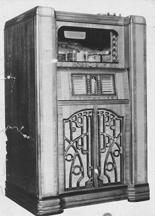
The Rock-Ola Model B "Rhythm King"
Design Patent D-102,194
Click to Enlarge
Click here if you want to learn how to get Patent Drawings
The 24 disc version was called "The Imperial" and the name seems to describe well the pretensions of this large jukebox. The cabinet looks like an Art Deco armoire with giant pilasters.
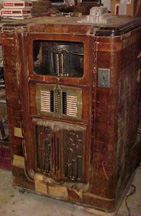
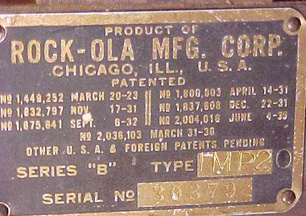
The Rock-Ola Model B "Imperial"
Click to Enlarge
The Rock-Ola "Monarch" and "Windsor"
This box is also fairly ponderous for its capacity. Note that David Rockola always took design credit on the patents.
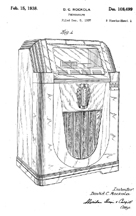
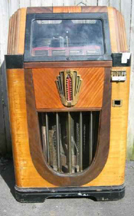
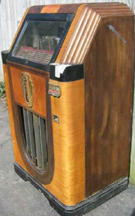
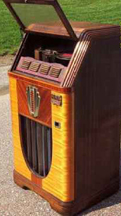
The Rock-Ola Monarch and Windsor Series
Design Patent D-108,494
Middle two photos: The Monarch, Far Right, the Windsor
Click to Enlarge
Click here if you want to learn how to get Patent Drawings
A Rockola Monarch appears for a split second in the 1947 film The Hucksters, an excoriation of the radio advertising business. Clark Gable and Deborah Kerr are romantically involved and visit the "Blue Penguin Inn" which used to be charming prior to WWII, but now turns out to be a sleazy roadhouse, complete with Jukebox and Pinball machine. You have to watch VERY carefully to see the Monarch.
1938 was a watershed year in jukebox design. As we have indicated, the Model 50 was a rehash of the previous failed designs. The Model 24 was a great departure from the old traditional Wurlitzer image -- and it was a lot bigger -- Model 24 had a footprint that was approximately 24% larger than the Model 50. Under most circumstances, when floor, counter, or shelf space was considered, the sale of a Model 24 should be more difficult, because it meant less space for other revenue earners such as tables or dance floor. In a completely unexpected turn of events, the Model 24 outsold the Model 50 by a ratio of 10 to 1! The message was heard loud and clear by management -- even though both machines were functionally alike, the one with "glitz" was clkearly preferred. This glitz was due to the use of phenolic resin based translucent panels. (Please note that I have adopted the term "Bakelite" as a shorthand term for the plastics used in jukeboxes included trademarked resins like Catalin and in some cases cellulose based products.)
Beginning eith the resounding success of Fuller's 1938 Bakelite confection, Wurlitzer released these colorful designs on a yearly basis. Even Bakelite countertop models were introduced. Each new generation of designs added features (bubble lights, polarized colors or 24 selection capacity.)
The wooden designs were offered for a while but were eventually discontinued. Fuller was able to implement one of the most successful branding campaigns ever launched. As shown above, this was done by the repetitive themes in the designs. For decades the “Wurlitzer Arch” was second only to Coke as the most recognized mark world-wide. Throughout the Golden Age, the arch was synonymous with jukebox.
The Wurlitzer Model 24
The Wurlitzer Model 24 was introduced in 1937. It was the first Wurlitzer model to offer 24 selections instead of 12, an innovation that shook the industry where "12 is enough" had been a maxim. This was also the first jukebox to incorporate illuminated plastics into its design. The company's evolution from heavy wooden cabinets to a bright and modern deco style helped to establishe Wurlitzer's pre-eminenence in the coin-operated phonograph industry.

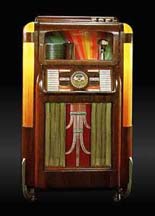
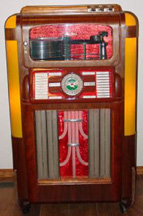
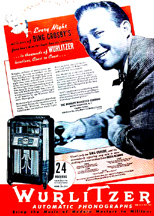
Wurlitzer Model 24
Design Patent D-111,599
The ad shows a Model 24 (in addition to Bing Crosby)
Click here if you want to learn how to get Patent Drawings
This was the start and later versions kept the basic form but added improvements -- and more lighting. It looks like the Wurlitzer advertising agency ignored the warnings of their style manuals and grammar teachers about alliteration -- check out the slogan in the Bing Crosby ad: " Bring the Music of Modern Masters to Millions. "
The Wurlitzer Model 500
This machine is distinguished by rotating color cylinders and a keyboard selection system. It is a very tasteful, particularly the delicate metalwork on the grille. This also marks the first use of the "winged" Wurlitzer badge. The 1953 musical Fast Company has a Model 500 in the opening scenes. The film is about horse racing and, appropriately, there is a statue of a horse on top of the jukebox.
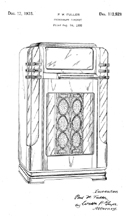
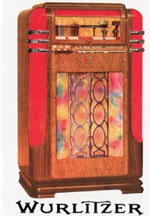
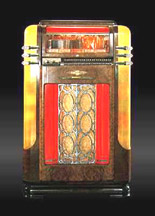
Wurlitzer Model 500
Design Patent D-112,521
Click here if you want to learn how to get Patent Drawings
The Model 500 was accepted at high end establishments. The 1938-1939 brochure states that:
"...[the] hardest nut for the music merchant to crack has proved to be the white tie and tails location... Few phonographs found welcome in this ultra-ultra atmosphere until the advent of the Wurlitzer Deluxe 500..."

Wurlitzer Model 500 in a USO Club
Circa 1944
Click to Enlarge
Click here if you want to learn how to get Patent Drawings
The Wurlitzer Model 600
The Model 600 was a down-sized version of the Model 500. (The 600 has two "chevrons" on its sleeves while the Model 500 has three) A nice example of this machine can be seen in the opening scene of the film The Blue Dahlia. Both front and back of the 600 can be seen as William Bendix rips off the cord because he cannot stand the "Monkey Music" being played.
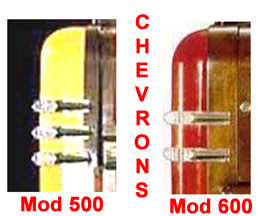
The Model 500 "Outranks" the Model 600
The apparent intent of the Wurlitzer company was to get rid of some older technology. The "600" was offered in two forms: one had the keyboard selector and the other had the old round Simplex Selector. The latter was sold at a considerable discount. For the keyboard models (as shown below), a "gee whiz" feature was inserted to take the place of the dial. This was the now-famous "Green Arrow" -- the center lit up in green and what appeared to be an arrow spun around and around until it pointed to the selection currently playing. This was a well-received novelty -- the company sold nearly 10,000 of them. They must have used up their entire inventory of simplex selectors, because that device never appeared on another Wurlitzer jukebox.
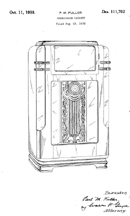
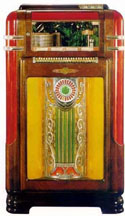
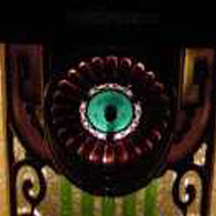
Wurlitzer Model 600
Design Patent D-111,702
Click here if you want to learn how to get Patent Drawings
Here is a video of a Wurlitzer Model 600 jukebox that shows the rotary selection and changer mechanism in action. The song is "Hey, Good-Lookin'", sung by Hank Williams.
Here is a video on the restoration of a Wurlitzer Model 616 jukebox.
The Wurltzer Model 700
Durng the years right before World War II, Paul Fuller designed five jukeboxes. The "Model 700" was the first of these. It is a lot like the Model 600 except that the "Crown" is starting to emerge and a "Keystone" is present for the first time. The Model 700 was the "economy" model of the series. About 9,500 of these machines were sold.

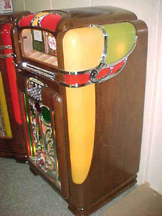
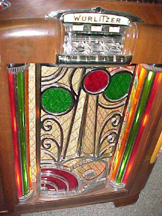
The Wurlitzer Model 700 Jukebox
Front, Side, Details of Grille
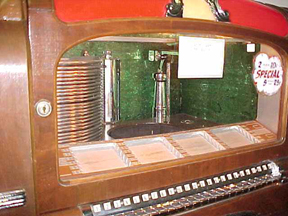
Wurlitzer Model 700 - Details of Selector Cabinet
Click to Enlarge
Here is a video of a Wurlitzer Model 700 jukebox that shows the selection and changer mechanism in action. The song is "You Send Me", sung by Sam Cooke.
The Wurlitzer Model 750
The Model 750 is all arch and no pilasters; an oval encloses both the playback window and the selector. It sold nearly 19,000 units making it the most popular box of 1941 and employed bubble tubes to highlight the selection keyboard.

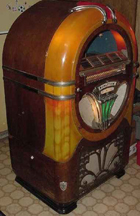
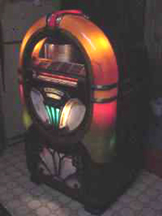
Wurlitzer Model 750 Jukebox
Lit and Unlit -- the last three show the kind of condition that is to be expected

Wurlitzer Model 750 Jukebox -- Details of the Changer
Click to Enlarge
Here are two photographs from the Office of War Information (OWI) showing a Wurlitzer Model 750 in a segregated facility, entertaining African-American troops.

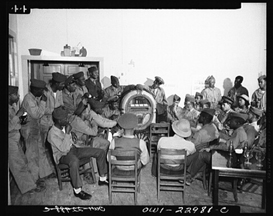
Wurlitzer Model 750 Jukebox Entertaining African-American Troops
Everything was segregated in the US Army in World War II
Circa 1944
Click to Enlarge
The Wurlitzer Model 800
The Model 800 is the Model 500 on steroids. It has the crown and keystone but it is dominated by immense pilasters that look like like pontoons. I suppose that the folks at Wurlitzer were wondering whether the arch or the pilasters were the dominant factor in sales. The Model 750 tested the arch and the model 800 tested the pilasters. In order to add even more emphasis, Wurlitzer located the longest ever color cylinders in the pilasters and a zebra-striped acetate made the color flicker like a live fire. The "800" did not sell well,and all subsequent models used the arch shape.



Wurlitzer Model 800 Jukebox Front and Side

Wurlitzer Model 800 Jukebox -- Details of the Coin Acceptor Click to Enlarge
Here is a video of the Wurlitzer Model 800 jukebox, playing "Silhouettes" by The Rays.
The Wurlitzer Model 850 "Victory"
Another "first" for this model was the very first application of Polaroid film. Behind the stained glass door, a polarizing unit spins 2 circular discs of film. Behind it are regular incandescent light bulbs (15 watts) that squeeze light directly on the stained glass peacocks. Instead of just changing colors, as the unit spins, the peacocks actually change hues before your eyes. It is absolutely mesmerizing and incredible to watch.
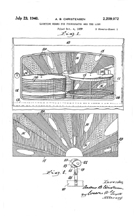
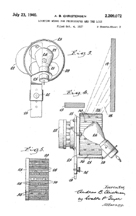
Creating Dramatic Patterns by Using Polarized Light
Patent No. 2,209,072
Click to Enlarge
Click here if you want to learn how to get Patent Drawings
The Model 850 was the first jukebox to use an electric selector as opposed to a mechanical one. All selector buttons are lit prior to making a selection. When the coin is deposited, two "make selection" lights come on. When the button(s) are pushed, that selection light goes out and does not come on again until the record is played. The light comes back on, indicating it can be selected again. In this way, you can't accidentally play a song that has already been selected. The advent of World War II saw a great cutback in jukebox production since the companies were assigned work in producing sensitive elecronic equipment for the Services. Unfortunately, only a few examples of the "850 were made, so few in fact, that a service manual for it was never published.

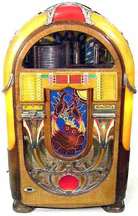
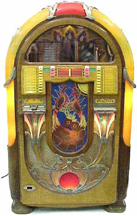
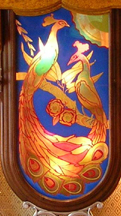
Wurlitzer Model 850 Jukebox
Lit and Unlit, Detail of Peacocks
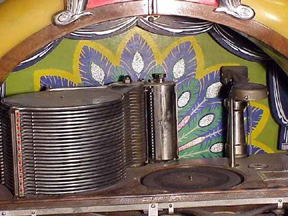
Details of Changer
Click to Enlarge
The Wurlitzer Model 950
The Model 950 is another beautiful object whose life was cut short by the War -- only 3,400 were made. This was the first jukebox to use fluorescent tubes and the first to use long tubes filled with methylene chloride, a liquid with a low boiling point. When the lights were turned on, bubbles would form and circulate througout the tube. These devices came to be known as "bubblers" or "bubble tubes". Internal mirrors made the gazelles on the box's face change colors as the same colors changed in the pilasters.

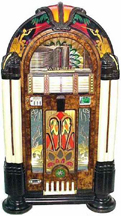
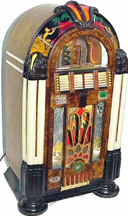
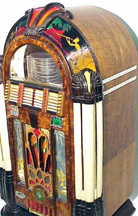
The Wurlitzer Model 950 Jukebox
Gazelle, Pipes Of Pan, Flutes of Pan
Click to Enlarge
Many of the internal components, including the coin chutes, coin box and tone arm post are made of wood since metal was in short supply during the War. This is the rarest of all the Wurlitzer "Golden Age" jukeboxes, and some say the most beautiful.
The Wurlitzer Model 1015
Shortly after WWII (when wartime restrictions on building materials were removed), the Wurlitzer Company introduced the Model 1015 Jukebox with great success, saving the company from near-bankruptcy brought on by the Depression. The 1015 pushed Wurlitzer forward as the leader of jukebox manufacturing, with 56,000 units being sold in less than 2 years. This was the Golden Age of jukebox production. The 1015 wasn't just a huge hit in the United States, but also appeared anywhere Americans went, following GIs all over the globe.
Also called the "1015-Bubbler", this juke is arguably the most popular jukebox of all time. It was also designed by Paul Fuller. With its illuminated, color-changing pilasters, 8 bubble tubes, shiny chrome and domed top, it is reflective of the positive, uplifted attitude of the post-war nation. The coin-operated 1015 plays 78-RPM records and has push-button Multi-Selector technology.
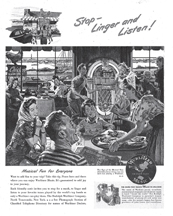
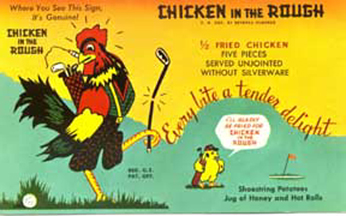
Swing Dancing and the Model 1015
Albert Dorne Ad and "Chicken in the Rough" Postcard
Click to Enlarge
Above is one of those memorable Albert Dorne ads that glorifies the Model 1015. The scene is in a New England seaside restaurant. Dad fusses over a map, while Junior is delighted to get his serving of "Chicken in the Rough". Parenthetically, this was a real restaurant chain -- half a chicken was breaded, fried and served in a basket with fries without silverware. I've also shown an advertising postcard for the chain. If you can't read it, the little chick (who is serving as caddy) says "I'd gladly be fried for Chicken in the Rough" There was a nationwide fad for the stuff in the 1940s. Today "CITR" items from restaurants are very collectible.
Chicken aside, this ad is significant in that it is the ONLY 1940s ad that shows people swing dancing in front of a Model 1015. That's it -- the entire legend, repeated ad nauseam on cutesy 1950s party favors, grows from this one ad.
The model 1015 was produced from 1946 to 1947, and was so popular that many of them survived into into the 1950s; in fact, this creation of the 1940s is an icon of the sock-hop and rock'n'roll era. By 1954 the popular 45-RPM records induced the Wurlitzer factory to make conversion kits to adapt the 1015. In 1986 Wurlitzer celebrated the 40th anniversary of the 1015 by manufacturing it once again, marketing it as the "One More Time". It had the classic design of the 1015 with all the latest technology, including the ability to play CDs.
Through the years, there have been many Wurlitzer 1015s that appeared in background shots of TV shows and films like "Cheers", "Friends", "Back to the Future" and "On the Waterfront" to name a few.



The Model 1015
Paul Fuller Design Patent D146,175
Click to Enlarge
Click here if you want to learn how to get Free Patent Drawings
Here is Frenesi as recorded by Artie Shaw playing on an original Model 1015 Jukebox
Watch Les Paul's version of Nola playing on the same machine.
The Wurlitzer Model 1080 "Colonial"
Paul Fuller, the creator of the previous masterpieces is credited with the design (his last for Wurlitzer) and he may have left in disgust because of it. It was explicitly designed for "conservative" establishments. The advertising booklet says,
"... Its graceful colonial-styled cabinet is a period masterpiece, rich in old world charm. Its illuminated mirror plastics have the glow and sparkle of fine cut glass. An early American lyre inspired its colorful grille. Its visible record changer reproduces a famous 18th century painting ..."
In other words, this is a jukebox for guys who wear brown suits. You can assume that no boogie-woogie was going to be played on this box. [see the video clip below.]
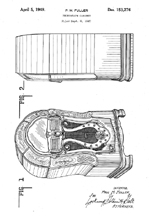


The Wurlitzer Model 1080 "Colonial"
Design Patent No. D- 153,276
The ad actually shows guys in brown suits...
Click here if you want to learn how to get Patent Drawings
Here is a video of the Wurlitzer Model 1080 jukebox (20th Century Technology Museum in Wharton, Texas), playing "Tata Ana," a polka by Fezz Fritsche. (This is certainly in keeping with the "Un-Deco" looks of the Colonial.)
The Wurlitzer Model 1100
Here is one of those marvelous Albert Dorne ads showing folks having a great time while the Model 1100 is playing.

Albert Dorne Ad Featuring the Wurlitzer Model 1100 Jukebox
The Model 1100 was a step in the direction of the new chrome and glass jukeboxes and is an evolutionary bridge between the "Golden Age" and the "Jet Age" of jukeboxes.
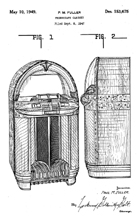
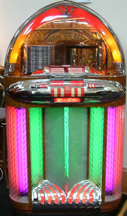
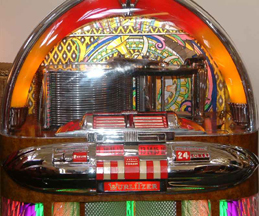
Wurlitzer Model 1100 Jukebox
Design Patent D-153,675
Click here if you want to learn how to get Patent Drawings
Here is a video of a Wurlitzer Model 1100 jukebox that shows the selection and changer mechanism in action. The song is "I've got the World by a String", sung by Frank Sinatra.
for the Wurlitzer Model 1100!
Here is the Table of Contents:
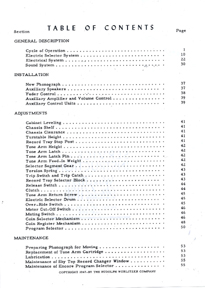
Click to Enlarge
The Service Manual:
- What's New About the Model 1100?
- Cycle of Operation
- Electrical Selector
- Electrical System
- Sound System
- Installation
- Adjustments
- Maintenance
- Oversized Schematics (pp 25,33,34,35)
The Parts Catalogue:
- Illustrated Parts Catalogue, Part 1
- Illustrated Parts Catalogue, Part 2
- Illustrated Parts Catalogue, Part 3
- Illustrated Parts Catalogue, Part 4
- Numerical Parts Catalogue
Jukeboxes by the Automatic Music Instrument Company (AMI)
AMI began in 1909 as the National Automatic Music Co, making automatic player pianos. Having designed a mechanism which allowed music rolls to be selected, this was adapted for use in phonographs, the first of which was produced in 1927. The mechanism used was the first that could play both sides of 10 records, allowing 20 selections. Aside from modifications to extend the number of selections, this mechanism was used for the next 30 years. The company was renamed to the Automatic Musical Instrument Company (AMI) after World War 2. The Automatic Canteen Company bought AMI in 1962, merging it with its subsidiary ROWE AC Services, a manufacturer of coin operated vending machines. Rowe-AMI is still manufacturing jukeboxes today.
The AMI "Streamliner"
The Streamliner was manufactured between 1938 and 1939. Of note is the center bar of the speakers. AMI introduced an elongated incandescent bulb called the "Lumiline" to provide illumination that did not appear to emanate from a point source. Late, fluorescent tubes were used for that purpose.
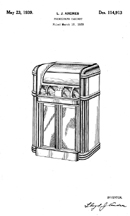
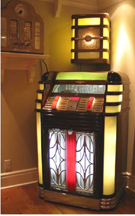
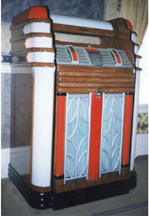
The AMI "Streamliner"
AMI Streamliner Design Patent D-114,913
AMI Streamliner Showing External Speaker
AMI Streamliner, with lights off
Click here if you want to learn how to get Patent Drawings
The "Streamliner" sold fairly well but was not in the same league as Wurlitzer. This design is quite a bit "brighter" than comparable Wurlitzer designs from the same period.
The AMI "Singing Tower"
AMI developed this unusual machine, known as the "Singing Towers," it employed an advanced sound system. Sound was reflected off the top of the dome and created an effect that made the patrons think that they were in the middle of the orchestra.
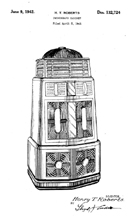
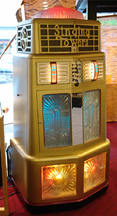
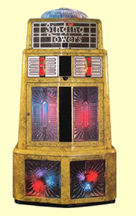
The AMI Singing Towers Jukebox (original)

The AMI Singing Towers Jukebox (duplex variant)
AMI Singing Towers Jukebox Design Patent D-132,724
Click here if you want to learn how to get Patent Drawings
The jukebox case is done in faux stone, and everything (except the slector keys) is glass nearly an inch thick. This was a very innovative design but it did not gain wide acceptance.
The AMI Model A, "Mother of Plastic"
This was called the "Mother of Plastic" in 1946 long before Saddam Hussein warned of the "Mother of Battles." Our research has, in fact, failed to turn up any Iraqi dictators who had a hand in jukebox design. This was the first jukebox to go beyond bakelite (and catalin) to use acrylic plastics. The box also marked the introduction of shaped fluorescent lights. In fact the only incandescent light was located just below the coin return slot to illustrate the red, green and blue jewels on the center post. There were two color cylinders on either side of the base.
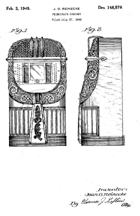

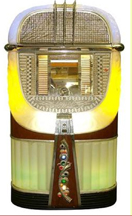
The Mother of Plastic
AMI Model A Jukebox
Design Patent D-148,576
Click here if you want to learn how to get Patent Drawings
Here is a video of the AMI Model A jukebox, showing very clearly how it got its name "Mother of Plastic." The song is "Rock around the Clock" by Bill Haley and the Comets. If you want to see an authentic "Mother" in a period setting, check out the film High Wall, a 1947 film noir classic. Near the end of the film, a scene is set in a tavern with a large dance floor dominated by the Model A.
The AMI Model B
This jukebox was issued in 1947 and is the downscale version of the "Mother of Plastic." It played 40 selections on 20 discs, a major innovation for the time. There were three color wheels, in both lower pilasters and in the dome. This was the last jukebox that was designed to play 78 rpm records exclusively.
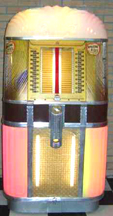
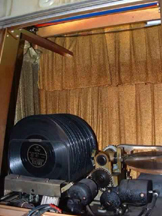

The AMI Model B Jukebox
Front View, Changer Details, Metalwork on Base
Click to Enlarge
Here is a video of a AMI Model B jukebox that preserves much of the plastic, although the changer has been replaced with a touch screen.
The AMI Model C
The Model C has a clear plastic enclosure over the chamger and is very reminiscent of the Wurlitzer Model 1100. Once could easily picture this as something off a World War II Bomber or maybe even a Flash Gordon spaceship. The jukebox was introduced in about 1950.
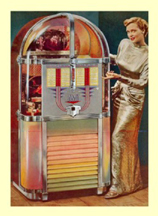
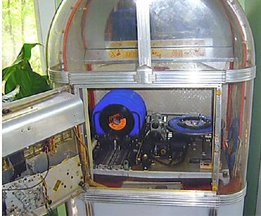
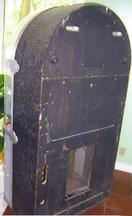
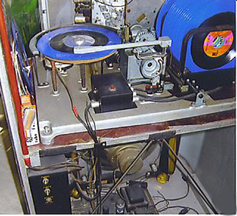
The AMI Model C Jukebox
Details: Front Door, Back, Record Player
Click here if you want to learn how to get Patent Drawings
Here is a video of insides of the AMI Model C.
The AMI Model D-40 and D-80
This is the AMI entry into the "future" and is quite similar to the Seeburg Model 100.
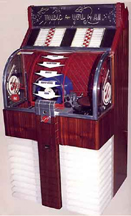
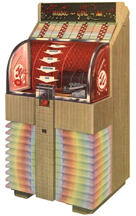
The AMI Model D
AMI Model D-40, 78 rpm record variant, shown in "demitasse mahogany"
AMI Model D-80, 45 rpm record variant, shown in "beechwood bisque"
Click here if you want to learn how to get Patent Drawings
Here is a video of the AMI D-80 in action, playing "Over the Rainbow" by Judy Garland.
This is a video of the AMI D-40 playing a 45 rpm recording of Chuck Berry doing "School Days" -- note that the 45's are encased in a sleeve (or sabot) to be held by the carriers that are still the diameter of a 78 rpm record.
The Seeburg Corporation
This company, created by Justus P. Seeburg before the turn of the century eventually came to dominate the jukebox field in the late 1950s. The Seeburg company was aggressive and innovative, especially in the area of sound quality and remote-operated wall selectors. They made attractive machines that sold respectably. The breakthrough came when Seeburg introduced the Model 100 which offered one hundred selections.
The Seeburg "Concert Grand, "Crown", "Regal", "Gem","Universal"
This was the 1937-1938 line of Seeburg jukeboxes -- their internal mechanisms were basically similar. There were three slightly different designs. The "Concert Grand" was the top of the line and the "Gem" was the bargain basement. From the ad (below) it looks like Seeburg had a "2-for-1" jukebox sale.
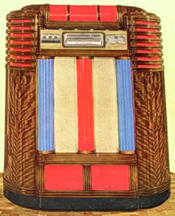

The Seeburg "Concert Grand"

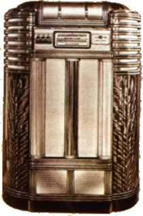
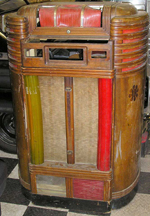
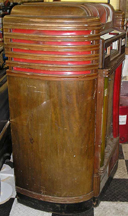
The Seeburg "Crown"
Design Patent D-109,339
The Design Patents for the Crown, Regal, and Gem are consecutive
Click to Enlarge
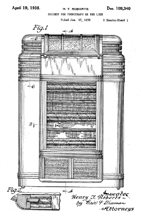
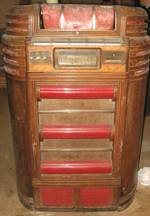
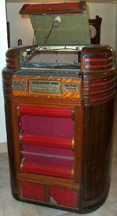
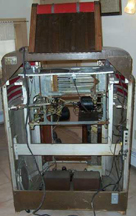
The Seeburg "Regal"
Design Patent D-109,340
Click to Enlarge

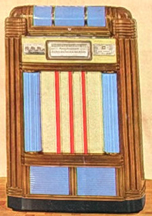
The Seeburg "Gem"
Design Patent D-109,341
This is a very rare item -- this is the only picture I could find
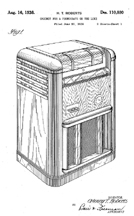
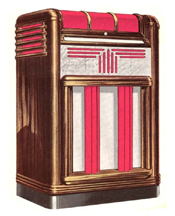
The Seeburg "Universal Cabinet"
Design Patent D-110,880
Limited issue in 1938
Click here if you want to learn how to get Patent Drawings
The Seeburg "Casino", "Mayfair" and "Plaza"
The "casino" line was offered in 1939. The mechanics are fairly unchanged from 1938, but the selector panel has been arranged to form a "V". This adds a bit of visual interest to the machine. No major technical innovations were introduced in this line.
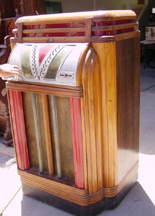
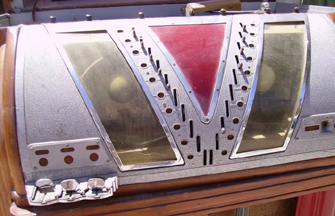
The Seeburg "Casino" (outside)
Unrestored model, full view and details of the selector panel
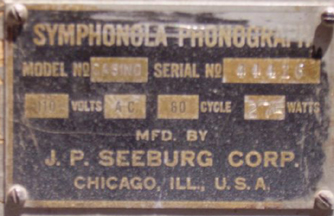
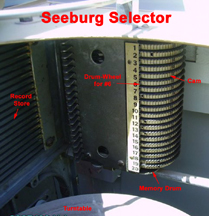
The Seeburg "Casino" (inside)
The Manufacturer's plate
Seebeurg jukeboxes never let the customer see the mechanism
Clearance for the tone arm required that Seeburg models have a "bulge" on top
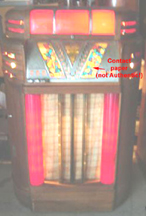
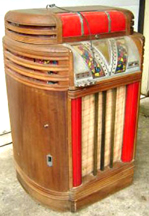

The Seeburg "Mayfair"
Middle of the line...
in this example, the selector panel has been covered with contact paper
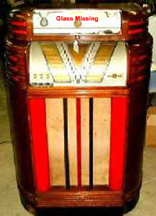


The Seeburg "Plaza"
The Economy model
glass is missing on the top..

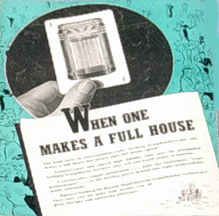
Advertisements for the Seeburg "Casino" Line
"Free the music and Dance..."
One makes a full house...
The "Casino" was the top of the line with the most embellishment, followed by the "Mayfair" and the "Plaza."
The Seeburg "Classic", "Vogue"
This is basically the same box as all the others (above). This version is reminiscent of the Wurlitzer 500-600 series as well as the Rockola Luxury Light-up. This styling is adapting to trends, rather than setting them. The "Vogue" was offered in "Marbl-Glo:"
- The companiy's brochure April 1939 defines "Marbl-Glo" as: "a quality finish that sets the Vogue apart from and above its competition."
- The same brocure quotes a Cabinet Maker: "Marbl-Glo is a radical step forward in cabinet treatment. Its application requires the utmost skill and care. Only trained finishers are permitted to apply the quality materials in the creation of a glowing, soft marble-like surface."
- An Operator was quoted as saying:"Marbl-Glo presents a strong and convincing sales argument that makes it easier to get blue ribbon locations."
It was just a faux marble finish.
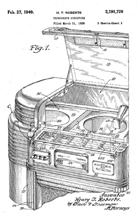
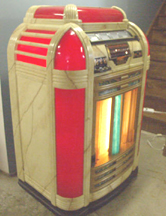
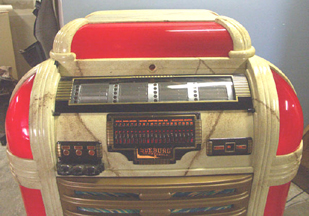
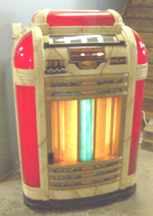
The Seeburg Symphonola "Classic (Exterior)"
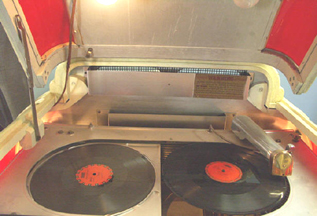
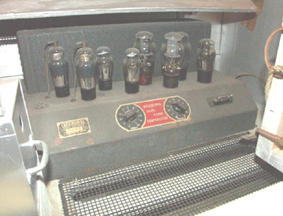
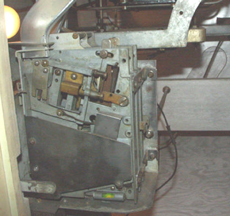
The Seeburg Symphonola "Classic (Interior)"
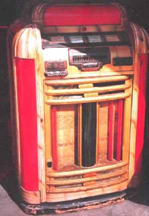
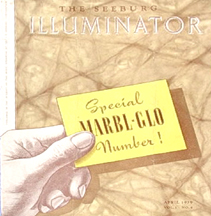
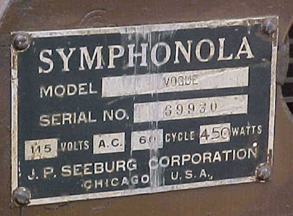
The Seeburg "Vogue"
All covered by Patent No. 2,191,729
"Marbl Glo" faux finish described in the Seeburg house magazine, April 1939
Click to Enlarge
Click to Enlarge
Click here if you want to learn how to get Patent Drawings
On a side note, the 1939 touting of "Marbl-Glo" as an upscale, refined finish was somewhat shattered by the introduction of the "Ray-O-Lite" electronic rifle range:

The "Ray-O-Lite" Target Game
Click to Enlarge
Apparently the soft marble glo set this thing apart from other amusement park gadgets. Last year's upscale is today's downscale.
The Seeburg Symphonola "Colonel", "Standard", "Major", "Envoy", etc.
The "Colonel" got its military title because it was the first of Seeburg's box units to be fitted with circuitry to enable remote wall units to make selections as well as the keyboard on the box. "All Electric" selection was an advertising theme for 1940. Other notable features included a "credit wheel" that kept the customer appraised of how many selections were remaining to be made. The unusual protruding top held playback equipment -- it was somewhat larger due to the volume of the electrical selection apparatus. This was a fairly massive machine. I, personally, do not like the big bulge on the top.
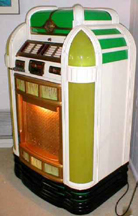
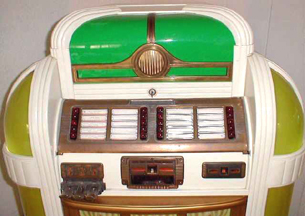
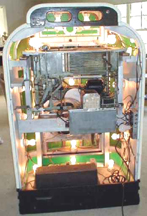
The Seeburg "Colonel"
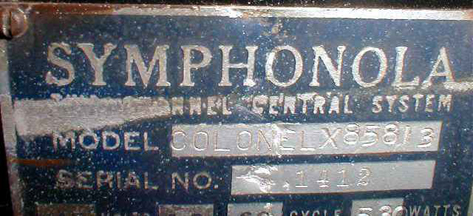
The Seeburg "Colonel" Manufacturer's Plate
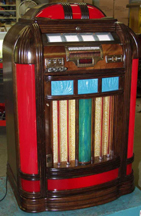
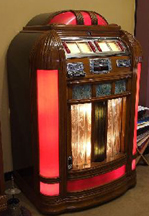
The Seeburg "Envoy"
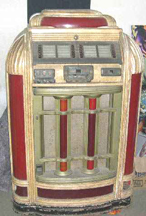
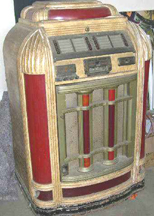
The Seeburg "Standard"
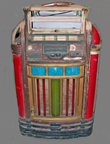
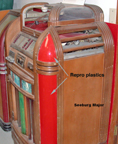
The Seeburg "Major" (Unrestored Condition)
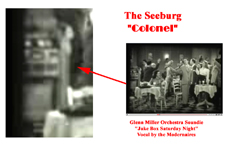
The Seeburg "Colonel" Featured in a Soundie
If you haven't heard of Soundies, Check out our page on Mills Company Panoram
This is the Glenn Miller Orchestra doing Juke Box Saturday Night
Click to Enlarge
Click here if you want to learn how to get Patent Drawings
The various boxes in this series are hard to tell apart. The "Major" and his superior, the "Colonel" are a good case in point. Our reader Dave offers this suggestion:
"... the Seeburg Major is smaller in size, and has one row of blue/red/green grille plastics on lower front door. The 'Colonel' has two rows. See attached pictures. The 'Colonel' picture is a telephone line version. ..."
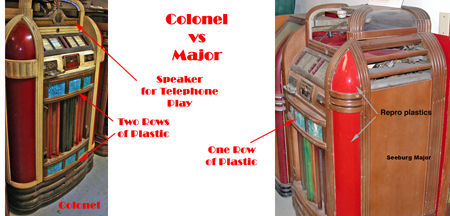
Difference Between the Seeburg Colonel and Major
See our discussion of the Telephone Jukebox
Click to Enlarge
A Seeburg Colonel appears in the Warner Brothers 1941 film Manpower, featuring George Raft, Marlene Dietrich and Edward G. Robinson. In the film, the "Colonel" (complete with telephone access capability) sits in Bennys Hamburger Hut, near Boulder Dam. The box probably came from the prop room because it is unlikely that telephone access would be available in that location. Look for it at about 1:18 into the film.
Here is a video of a Seeburg "Classic" jukebox in action. The song is "Only You", performed by The Platters (on record) along with an inept dude trying his hand at Karaoke.
The Seeburg "Commander", "Cadet", "Concertmaster", etc.
The unusual appendage at the top of the 1940 vintage Commander and its littermates is the "Dual-Toneflow" system that had vertically and horizontally oriented speakers to project sound throughout the room. Seeburg also began using polarizers to induce color spectrum effects. In their penchant for creating product names, this was called "Polarized Rainbo-Glo".
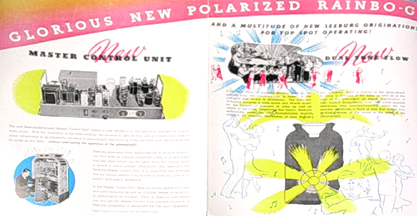
Illustration of the Dual Toneflow System and Polarized Raninbo-Glo

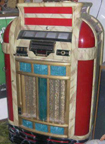
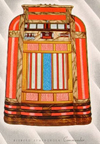
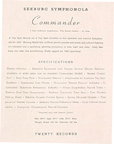
The Seeburg "Commander"
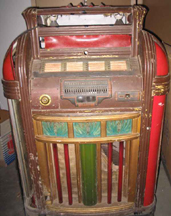

The Seeburg "Cadet"

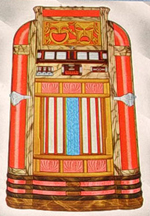

The Seeburg "Concertmaster"
Patent No.2,526,788
Note that the brochure suggests that this machine is for a "Top Spot"
Click to Enlarge
Click here if you want to learn how to get Patent Drawings
The Seeburg 9800 "Hi-Tone"
During the 1940s, Seeburg, Rock-Ola and AMI experimented with "High Fidelity" sound. Seeburg gradually adapted its novel (round) model 7800 ("The Barrel") in several cycles to achive the "Hi-Tone Deluxe" Model 9800.
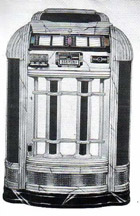
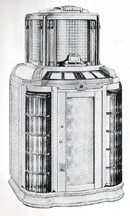

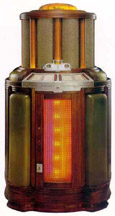
Evolution of the Seeburg 7800-9800 Series
(left to right)
Symphonola Design Patent D-
Symphonola Standard 7800 -- no raised high frequency speakers
Seeburg 8200 - the high frequency speakers appear Symphonola Deluxe 9800
Hi-Tone Deluxe

1941 Patent for the Seeburg 9800
Design Patent D- 130,049
Click here if you want to learn how to get Patent Drawings
The basic mechanism for projecting the sound was the Model 9800 "Hi-Tone Deluxe" system that emerged with the "Commander" seres. Sondsw were projected against a metal funnel to reflect music into the room. The 9800 had one color cylinder behind the glass door in the front. The "pillars" that ostensibly held up the top were called "candlelight pilasters" in the company literature.
The Seeburg Models S-146 - S-148 Symphonola aka "Trashcan"
These three models are very similar, having the unusual round shape that is larger at the top than at the bottom, sort of like an ordinary trashcan (hence the nickname.) There are only subtle differences between the three:
- The S-146 (1946) was made of dark wood and had a smooth pink dome
- The S-147 (1947) was made of dark wood-grained metal and had a smooth white dome
- The S-148 (1948) had real blond wood and a fluted pink dome as well as a color cylinder in the dome and base
These were popular, well-received jukeboxes -- there may have been 80-90,000 of all three series made.
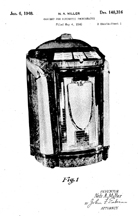
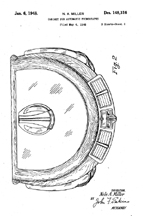
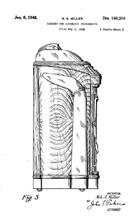
Design Patent Diagrams for the Seeburg Model S-148 Symphonola
Design Patent D-148,316, Drawings 1-3
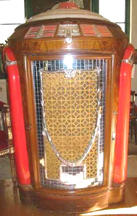
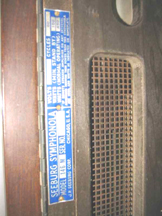
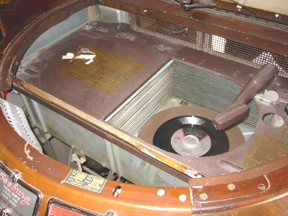
Seeburg Model 146
front view, manufacturer's plate and details of the record changer
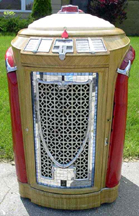
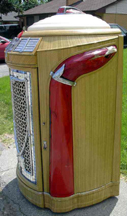
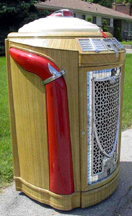
Seeburg Model 148
Click here if you want to learn how to get Patent Drawings
Here is a video of a Seebburg "Trashcan" jukebox that opens the lid to show the selection and changer mechanism in action. The song is Little Darlin, performed by The Diamonds.
If you look closely, you can see a "Trashcan" (wood model 146) in the bus stop set in the Marilyn Monroe film Bus Stop. There is a Model 147 in the film The Girl Can't Help It -- in a bar, a patron plays "Cry me a River" by Julie London and Tom Ewell reminisces his relationship with Ms. London.
The Seeburg M100A "Modern Classic"
This jukebox put Seeburg ahead of Wurlitzer -- it was the first jukebox to offer 100 selections. The advent of 45 rpm records made this easier to design, but it marks the end of the arch shape, moving more to a trapezoidal prism. This was the first Seeburg jukebox to have the mechanism visible to the public.

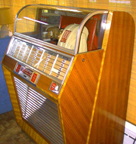
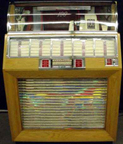
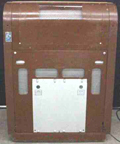
The Seeburg M100A "Classic"
Pioneering in Offering 100 Selections
Patent No. 2,594,565
Click here if you want to learn how to get Patent Drawings
You may see an M100A in the film noir classic While the City Sleeps, directed by Fritz Lang. The M100A is located to the right of the entrance stairs to "The Dell", the bar in the basement of the Kyne Building. In addition, the M100A is also in the film Anatomy of a Murder, prominently featured in Barney Quill's bar.
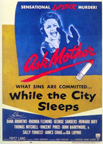
Poster for the film While the City Sleeps
Watch Closely or you'll mis it!
Click to Enlarge
Here is a video that shows the details of the Seeburg M100A in action, playing Hound Dog by Elvis Presley.
Rock-Ola Jukeboxes
The Rockola Company was manufacturing jukeboxes long before the Rock'n'Roll era, and the name "Rock-Ola" is not a portmanteau for the genre but rather the name of its energetic and innovative founder David Collin Rockola. His work began in the 1920s and included all kinds of mechanical devices including slot machines, parking meters and motor scooters.
The Rock-Ola "Luxury Light-Up"
The official name for this jukebox was the "Master Rockolite" although it quickly became known as the "Luxury-Light-Up." It was introduced in 1940 and clearly reflects influences from the Wurlitzer 24-500-600 series. David Rockola's name is on the patent, but it is unlikely that he designed this machine. Note the very unusual and striking metal grille.
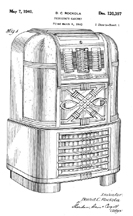
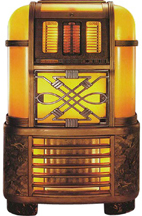
Rock-Ola "Luxury Light-Up"
Design Patent D-120,397
Click here if you want to learn how to get Patent Drawings
This was the flagship of the Rockola pre-war line.
The Rock-Ola "Spectravox"
This unusual machine had a telephone-dial selector -- if you wanted number 15, you dialed put your finger in the hole numbered "15" and dialed away. The changer was not located in this cabinet -- rather, it was hidden away in a back room in a unit called the Playmaster. The Spectravox took up a small amount of floor space which made it more saleable. The cabinet is made of metal with faux graining.
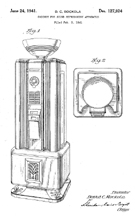
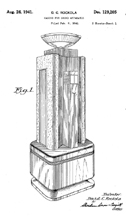
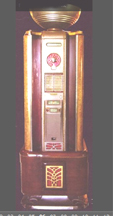
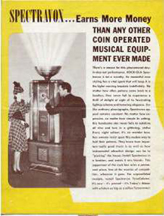
Rock-Ola "Spectravox" Jukebox
Design Patent D-127,924 and 129,205
Click here if you want to learn how to get Patent Drawings
The bowl on the top is always an item of curiosity. The brochure (above) is misleading -- the speaker was at the top of the column and sound reflected off the metal bowl. (Sound was not projected upward from the bowl as the ad would have you believe.)
The Rock-Ola "Commando" and "Premier"
This is a self-contained variant on the Spectravox. The selector, changer and playback mechanism were enclosed in the unusual cabinet. If you squint at it, it is almost as if the Spectravox is being enveloped by a cloud of fire. Plastic was in short supply during and right after World War II, so all the surfaces are made of glass, renedring the "Commando" quite delicate.
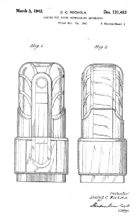
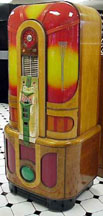
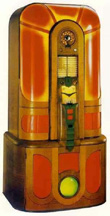

The Rock-Ola "Commando" and "Premier"
Design Patent D-131,483
Rockola also offered a model with an upward-firing speaker called "The Premier" (Far right)
Click here if you want to learn how to get Patent Drawings
A version with a Spectravox-like bowl on top was offered as the "Premier"
The Rock-Ola Model 1422 "Magic-Glo"
Beginning in 1946, Rock-Ola introduced several machines featuring the "arch" design that had become a jukebox icon. The series began with Model 1422, although the series uses identical technology, differing only in decor. The Model 1422 is quite conservative and appears to take a cue from the Wurlitzer 850. This model had color cylinders in both the grille and the pilasters. The crown was illuminated by a fluorescent bulb and the shoulders by incandescents. This was the first Rockola Model that allowed the customer to see the mechanism. An 18th century pastoral scene was painted on the walls of the chamber that held the changer.
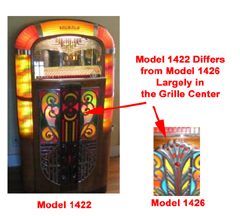
The Rock-Ola Model 1422 and 1426 are Qute Similar
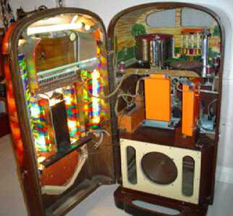

The Insides of the Model 1422 Details of the Fluorescent Lights
Here is a video of the Rock-Ola Model 1422 jukebox (owned by a Japanese collector), playing "La Bamba" by Ritchie Valens.
The Rock-Ola Model 1426
This uses a bit more metal and less wood than the Model 1422. The only differences between this and the 1422 are:
- Center strip is metal, not wood
- Color cylinders only in the Pilasters
- Mural behind the changer is quilted gold cloth instead of a pastoral scene
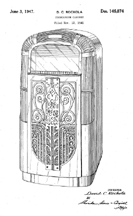



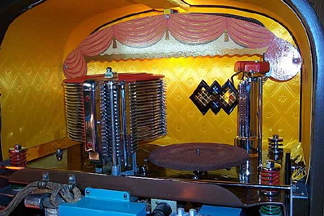
The Rock-Ola Model 1426
Design Patent D-146,874
That's paint instead of etched glass in the window
Click here if you want to learn how to get Patent Drawings
The glass in the window is not etched -- the "frosting" is painted on -- and bedevils restorers.
The Rock-Ola Model 1428 "Magic-Glo"
This box uses deeply molded acrylics on the pilasters and arch, reminiscent of the AMI Model A and Model B; it has a keystone, reminiscent of the Wurlitzer jukeboxes. The body of the box was wood but the door was blonde-grained metal. Only one color cylinder was used and it is in the center. Otherwise, this is exactly the same box as the Model 1422 and 1426. It is a lot less conservative.

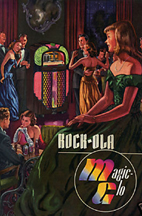
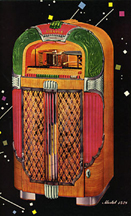
The Magic-Glo
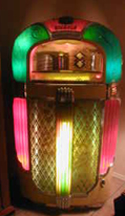
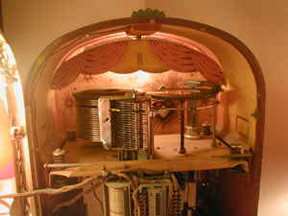
Design Patent D-149,589
Note that the people in the ad are wearing tuxedoes and dancing to a jukebox...
Click here if you want to learn how to get Patent Drawings
Here is a video of a Rock-Ola model 1428 jukebox playing Begin the Beguine, by the Artie Shaw Orchestra.
The Filben "Maestro"
The Batavia Metal Products Company made less than 900 of these and was forced out of business in the mid 1940s because they could not get materials. One suspects that the other manufacturers colluded in this process.

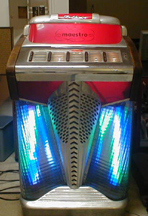
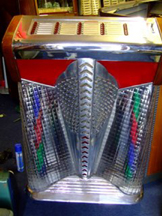
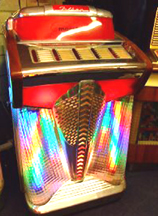
Filben FP-300 Maestro
Filben Changer patent No. 2,274,921
Batavia Metal Products Company
Click to Enlarge
In all likelihood, the Filben is one of the rarest (if not the rarest) of all jukeboxes. William Filben invented a new 30 record changer mechanism and took it to David Rockola who agreed to manufacture and distribute the machine. They were to be made under the name "Filben" so as not to undermine the Rock-Ola brand while the new changer was being tested in the marketplace. The first prototype models were made in September 1938. Unfortunately Filben died, and his heirs decided to leave Rockola and form a new company called the Filben Manufacturing Co.; The Batavia Metal Products company actually produced the machines and they were distributed by the U.S. Challenge Co. of Chicago. [The first cabinets were briefly named Mirro-cle Music, an amalgamation of the two words mirror and miracle.] Production was halted because of the war. In 1947, Maestro was produced for a short period. Apparently, two versions were made, one with red plastics often referred to as the FP-300 and another, even rare one with green plastics was designated FE-300. (You can also see them listed as FP-305 and FE-305.)
David Rockola was not thrilled at the possible competition from the Filben, since his boxes only had 20 selections while the Filben had 30. Rockola was able to block production of the Filben after only 896 units had been produced, winning a patent infringement case in August of 1948. The Filben passed into history.
The Mills Novelty Company
The Mills Novelty company (no longer in business) was once a leading manufacturer of coin operated devices, including slot machines, vending machines, penny scales, and jukeboxes. This company was the manufacturer of the Panoram, a jukebox that showed film clips that have come to be known as "Soundies" -- which give us a glimpse of the best bands and dancers in action. We are planning a separate chaper on the Panoram, look for it.
Our extensive patent research has not been able to turn up any designs for the Mills jukeboxes shown below, although they are two of the most attractive ever produced. Our guess is that the two were designed by either Fred Meagher or Willard Martling, who did other work for the Mills company during the late 1930s. We have been able to find some cabinet designs by these men, but they are not the "Empress" or "Throne of Music." These examples are shown below.
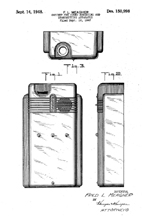
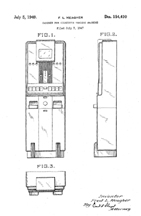
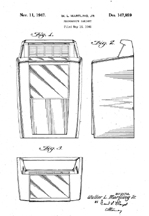
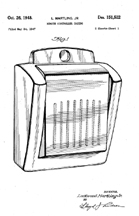
Work by Meagher and Martling for the Mills Novelty Company
Meagher, Receiver Cabinet Design Patent D-150,998
Meagher, Vending Machine Design Patent D-154,410
Martling, Jukebox Design Patent D-147,859
Martling, Jukebox Design Patent D-151,522
If you know the designers of the Mills jukeboxes shown below, please contact us
Click to Enlarge
Click here if you want to learn how to get Patent Drawings
Between 1929 and 1948, the company manufactured and sold jukeboxes by the names of Hi-Boy, Troubadour, Dancemaster, Do-Re-Me, Swing King, Zephyr, Studio, Throne of Music, Empress, Panoram, and Constellation.
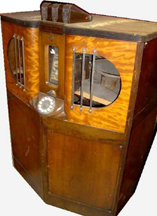
The Mills "Do-Re-Mi" Jukebox
a Dud...
Click to Enlarge
Most of these are incredibly rare -- and from what we have see, boring. We are going to focus on two, the Empress and the Throne. Those with interests and or pictures of other Mills jukeboxes should Contact Us.
The Mills "Empress"
This is a very elegant machine that clearly reflects the experience that Mills Novelty had in making slot machines. Many people like this design which dates from 1939. The machine has the beginnings of an "arch" and has a keystone.
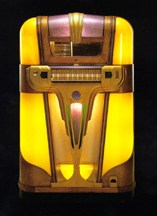
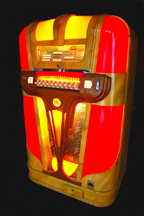


The Mills Novelty Co. "Empress"
Yellow Color Scheme, Red Color Scheme (lit and unlit) and Grille Detail
Click to Enlarge
The metal facing that ties the selector and the speaker grille is styled with delicacy. There were a number of color combinations available but the yellow/violet combination may not be correct from a historical perspective. Our reader Dave comments:
"... The [yellow/violet] photo is cut off on bottom and the purple center plastics are photographers artistic license, it never came with purple plastics. Here is a better picture of a historically correct Mills Empress... Mills machines did not work well on location, as they ate records... I Spoke to a serviceman from the 40's who said he had 'job security' servicing Mills jukeboxes ..."
Here is Dave's photo and the cover of his brochure for the Mills Empress.

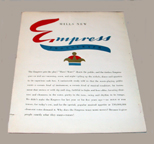
Dave's Empress
No violet...
Click to Enlarge
It appears that the "Empress" was the model for the jukebox shown in this 1946 Disney cartoon called "All the Cats Join In" featuring Benny Goodman.
Apparently, back in 1946, the Wurlitzer 1015 had not yet achieved iconic status.
The Mills "Throne of Music"
Although the name of the jukebox is a bit preposterous, this was the down-scale version of the "Empress" It has the same basic frame, selector and changer without the detailed and expensive metal facing.
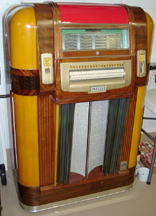

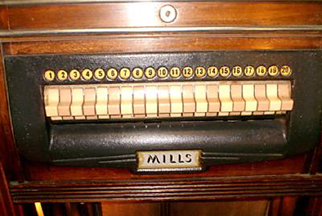
Mills "Throne of Music" Exterior
Front View, Side View, Selector Keys
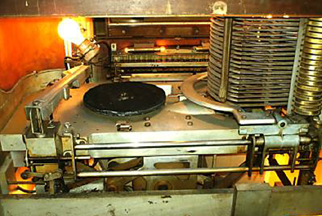
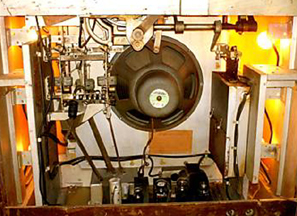
Mills "Throne of Music" Interior
Changer Mechanism and Audio Components
Click to Enlarge
Both the "Throne" and the "Empress" had a modest popularity.
The Packard Company
This was NOT the company that made fine automobiles, but the creation of Homer Capehart, reputed by some to be the "father of the jukebox industry". During the 1920s, he had very mixed success in the coin operated phonograph business. In 1932 Capehart formed Packard and developed the Simplex mechanism for automatic record changing. He sold the device to Wurlitzer and , as Operations Manager, moved Wurlitzer to the forefront of the jukebox business. After becoming a millionaire, he was elected to the United States Senate as an ultra-conservative Republican, a crony of Joe McCarthy. When you think of those carefree 1950s epitomized by the Model 1015, there is also the underlying reality of the Witch Hunts and bigotry -- For better or worse, Capehart gave us both.
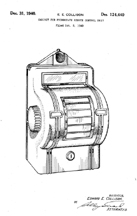
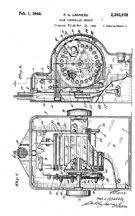
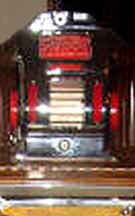
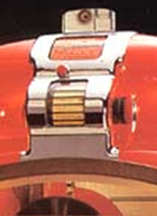
The Collison/Lannerd Selector, Unique to the Packard Series
Collison Jukebox Selector Cabinet D-124,440
Lannerd Jukebox selector Control Mechanism, Patent No. 2,340,478
Collison Lanard Selector on Packard Manhattan (left) and Pla-Mor (right) Jukeboxes
Click to Enlarge
Click here if you want to learn how to get Patent Drawings
Capehart left Wurlitzer in the mid 1940s and resumed producing jukeboxes under the Packard name. He was forced to use a new Collison/Lannerd 24 disc selector, since Wurlitzer held the patent on the Simplex. This mechanism produced an ugly "bump" on the crown and may have put customers off.
Capehart was a U.S. Senator at the time these models were being produced.
The Packard "Manhattan"
This was Packard's "Upscale" model for 1956. The unusual "headpiece" contains the new Collison/Lannerd changer that was operated by rotating the red plastic dial. The cabinet was made of fine woods, and the frosting on the window is real etching. The mechanism was chromed and the lighted panels are glass.
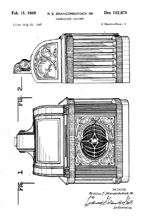


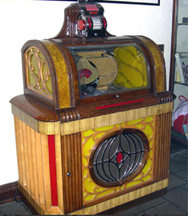

The Packard "Manhattan"
Design Patent D-152,670
Click here if you want to learn how to get Patent Drawings
This system held 24 records, but only played one side.
The Packard "Pla-Mor"
The Pla-Mor was the downscale offering for 1946. Deep molded plastic panels were illuniated by incandescent bulbs. This did not have the fine cabinetry of the Manhattan. I'm not thrilled about either of the two Packard jukeboxes because the selection mechanism makes them top-heavy.
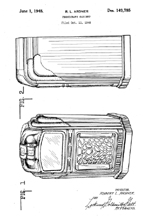
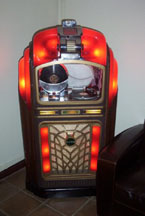
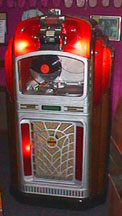
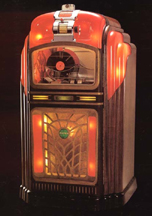
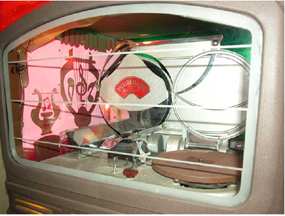
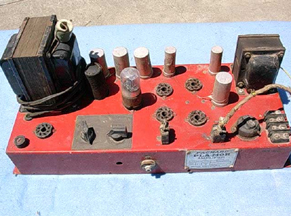
The Packard "Pla-Mor"
Design Patent D-149,785
The Outside is Futuristic -- the Amplifier certainly is not
Click here if you want to learn how to get Patent Drawings
This system also played 24 records, one side only.
Once again, you have a some choices:
- Read about Jukebox Mechanics Separate page
- Read about Jukebox Companies Separate page
- Read about The End of the Jukebox Era Separate page
- Look at Some Other Kind of Swing Era Nonsense
Counter for THIS Web Page
Home | About Lindy | 1940s Collectibles | Upcoming Events | Vintage Clothing
The Guide - Establishments - Travel - Accessories
Music | Links | Photo Gallery | Extras | Contact